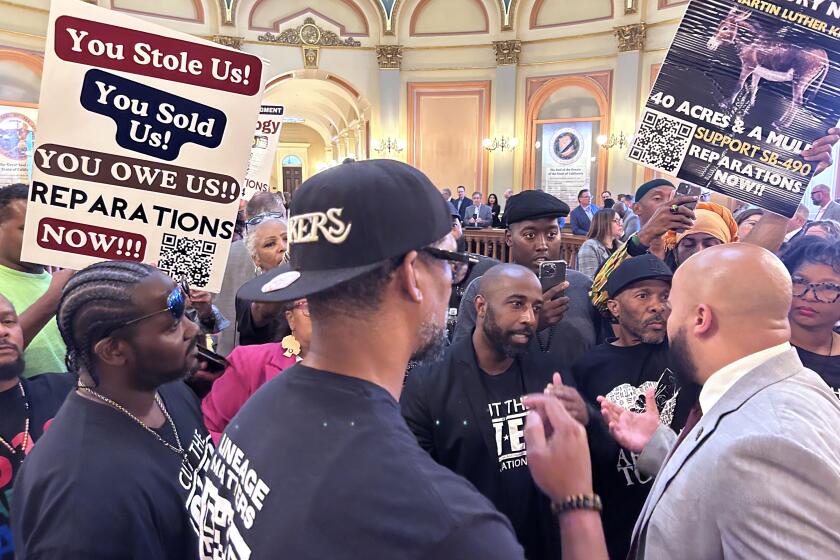Public’s Demand for Pepper Spray Is Bigger Than Supply in L.A. Area : Self-defense: Many stores are awaiting shipments from distributors or state authorization. More product should be available next week.
- Share via
During the past year, Susan Morrow has purchased the three items she considers necessary for survival in Los Angeles: a 9-millimeter pistol that she keeps under her bed, a stun gun that she carries in her car and a brass whistle that she keeps on her key ring.
Morrow had hoped to add pepper spray to her arsenal Tuesday, the first day the spray was made available to the public in California.
She called gun stores. She called shooting ranges. She called self-defense firms. But no one she contacted said they were selling the spray. Finally, she called a newspaper office.
“I’ve been waiting months for this. Where,” she asked, a hint of desperation in her voice, “can I get some pepper spray today?”
Although California stores were authorized to make the pepper spray available Tuesday, many stores were waiting for their shipments from the distributor. Others were waiting for state workers to inspect their businesses and authorize them to sell the product.
Most gun shops and self-defense firms said they would not be able to sell the pepper spray until later in the week or early next week. The few who were able to sell the spray Tuesday were deluged with customers.
“We’re getting so many calls we can’t get everyone in . . . right away,” said Milo
Speriglio, director of the Nick Harris Detective Academy. “We even got a call from a video company that wants the spray for all their employees.”
California joins 47 states that allow pepper spray for self-defense. Still, there is some controversy over its use. The American Civil Liberties Union has criticized making the spray available to the public, calling for more research on its safety and reliability.
“We’d love to have a magic bullet that would save lives and not cause injury,” said Mary Tokita, director of media relations for the ACLU’s Los Angeles office “But this isn’t it. There are a number of questions that need to be answered. Using the public as guinea pigs isn’t a good idea.”
Although a number of suspects exposed to pepper spray during arrests have died in custody, “we think it’s probably coincidental,” said David Boyd, a director for the National Institute of Justice, which is conducting an extensive study on the substance. In only one case has a medical examiner attributed pepper spray to the fatality, Boyd said. And it is questionable whether the spray was the direct cause of death in that case, he said.
Pepper spray will incapacitate a suspect--”to the extent that they are forced to their knees”--about 90% of the time, Boyd said. But even in those cases where suspects, usually those who are mentally deranged or under the influence of drugs, are not fully incapacitated, the spray can be effective. They still must close their eyes for several minutes, Boyd said.
*
Tear gas, he said, is much less reliable. Tear gas has a tendency to vaporize, and a cloud of the gas can drift back onto the user.
Deputy Steve Wilkinson of the Los Angeles County Sheriff’s Department has been impressed with the results of the spray during its use in the field the past two years. He recalled a recent family disturbance in South-Central Los Angeles where a combative, unruly suspect threatened officers.
“After he was sprayed, he immediately went to his knees, and we walked around and handcuffed him with no resistance,” said Wilkinson, who also has a weapons instruction business and plans to soon begin selling pepper spray. “The pain is so intense, the suspects don’t want to do anything except go along with the program.”
Oleoresin capsicum, the scientific name of the substance, is a pepper extract in an oil base that sticks to the eyes, nose and mouth. The spray has a blinding and choking effect and overpowers a person with a burning sensation that makes breathing difficult.
Because the only variety of pepper spray that dealers are authorized to sell was approved by the state two weeks ago, firms did not have much time to order shipments. Suppliers have been deluged by orders from more than 200 California firms. Dealers that do not have permits to sell tear gas now have to be cleared by state workers to sell the spray, a process that should be completed by the end of next week.
About 200 approved retail outlets in the state--35 in the Los Angeles area--will be selling pepper spray.
It will be much easier to obtain the spray than tear gas. In most cases, tear gas certification takes about two hours of training at a community college, law enforcement agency or weapons range. Applicants then have to visit a retail outlet to purchase the tear gas.
Those who want to obtain pepper spray can do it all at one location in about 30 minutes. Applicants can either watch a 30-minute training video or take a 30-question test and then demonstrate their ability to use the canisters.
Those who have taken a Mace class must pay a $12 state certification fee to carry the spray; all others must pay $17. The cost of the spray is $15 to $20.
Herb Danner, an executive with Defense Technology Corp. of America, which manufactures the only variety of pepper spray authorized for use in California, has been sprayed more than 20 times--voluntarily, for testing purposes.
“The pain is excruciating . . . you don’t want to know about it,” he said.
More to Read
Sign up for Essential California
The most important California stories and recommendations in your inbox every morning.
You may occasionally receive promotional content from the Los Angeles Times.










